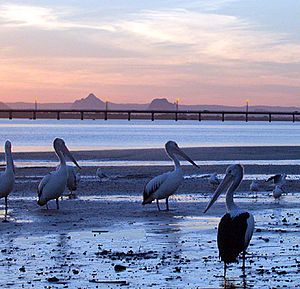Pumicestone Passage facts for kids

The Pumicestone Passage, also called the Pumicestone Channel, is a slim stretch of water in Queensland, Australia. It flows between Bribie Island and the mainland. To the north, it starts near Caloundra, and it stretches south all the way to Deception Bay. This passage is about 35 kilometers long and is a special place for nature and history.
Contents
Discovering Pumicestone Passage
The Pumicestone Passage got its name from an early explorer. In 1799, a British explorer named Matthew Flinders sailed into Moreton Bay. He was exploring the coast of Australia on his ship, the Sloop H. M. 'Norfolk'.
When Flinders explored this waterway, he noticed a lot of pumice stone along the shores. Pumice is a light, porous rock formed from volcanic eruptions. Because of all the pumice he found, he named the area "Pumice-stone River" on his maps. He spent about two weeks exploring the bay and naming different spots, including Point Skirmish.
A Home for Wildlife
The Pumicestone Passage is a very important natural area. In 1986, it became part of the Moreton Bay Marine Park. This marine park helps protect the amazing plants and animals that live here. The passage itself is over 35 kilometers long and covers about 63 square kilometers of water.
Water and Land Features
The marine park includes 24 islands and has about 240 kilometers of shoreline. A large part of the passage, about 80%, is shallow, less than two meters deep. This shallow water is perfect for many creatures. The area has different types of habitats, including:
- Mangroves and saltmarshes
- Sand flats and mud flats
- Coastal dunes
- Seagrass meadows
Amazing Animals
Many different animals call the Pumicestone Passage home.
- Dugongs: These gentle sea mammals often visit the passage. They come to feed on the seagrass that grows on the bottom of the channels.
- Dolphins and Turtles: You can also spot dolphins and various types of turtles swimming in the waters.
- Birds: Over 350 different kinds of birds live in or visit the passage. It is part of the Moreton Bay and Pumicestone Passage Important Bird Area. This means it's a crucial spot for many migratory birds, especially waders or shorebirds, who travel long distances.
See also
 In Spanish: Pasaje Pumicestone para niños
In Spanish: Pasaje Pumicestone para niños



